RallyMK1
Forum Replies Created
- AuthorPosts
-
There are pots internally, no digital adjustment on this one. I haven’t gotten into the service menu so far, just haven’t needed to. I’ll explore that later if it comes down to it.
Here’s a pic of it in its final spot, matched up with the Beosystem 6500 and some Beolab speakers.
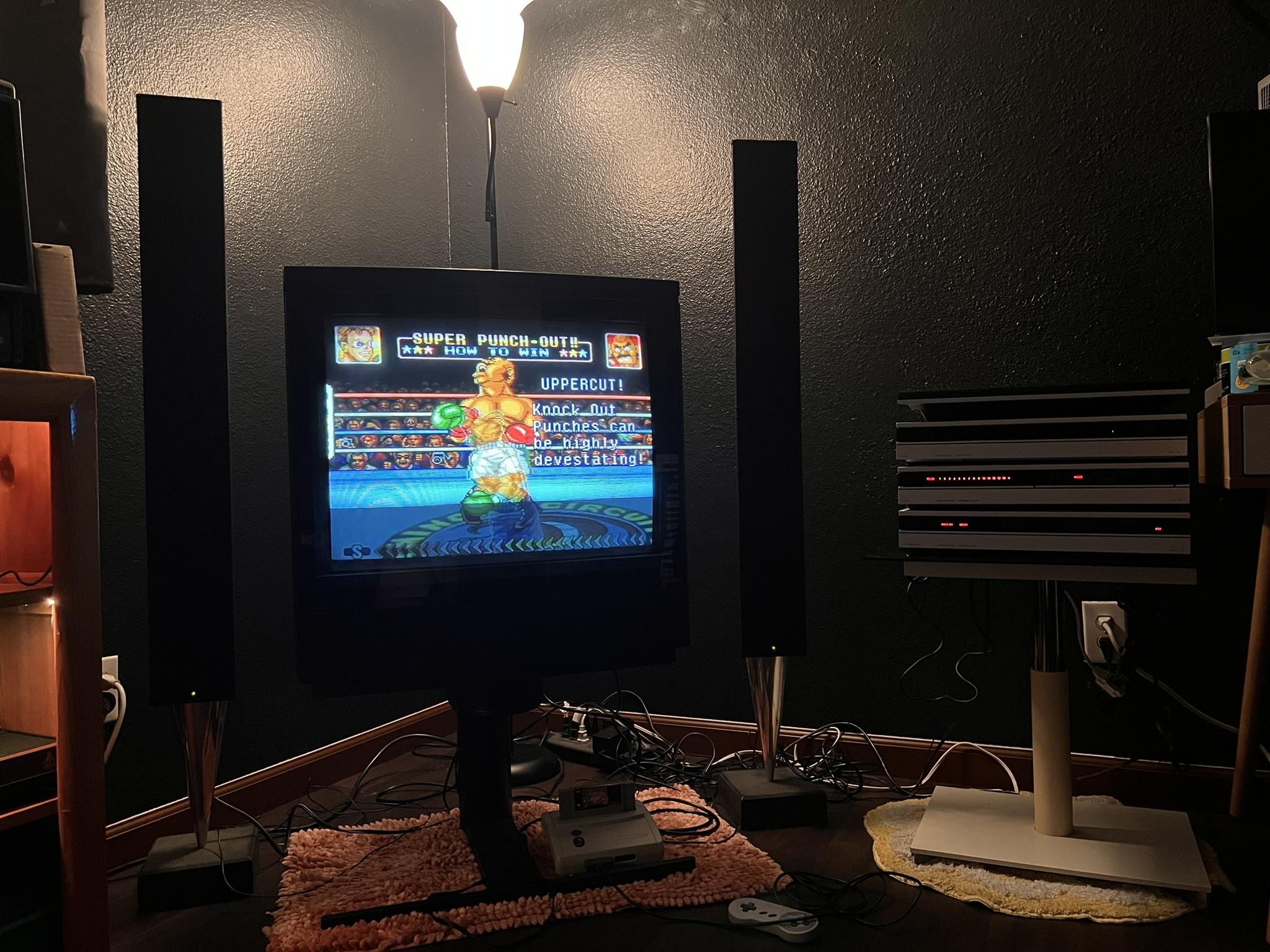
Here’s a nice closeup:

Guys, repairs are complete, and it’s in better shape than previously thought! It turns out the e-wasted B&O was an MX 5000, not a 5500, so its deflection circuit didn’t behave the right way with my yoke. The guy working on my set managed to get it up and running with my original boards, and found that the failure was mainly due to a mix of issues, including a blown HOT (which I had replaced!), trace corrosion from failed caps, a bad diode, and a shorted thermistor which ran the degauss coil.
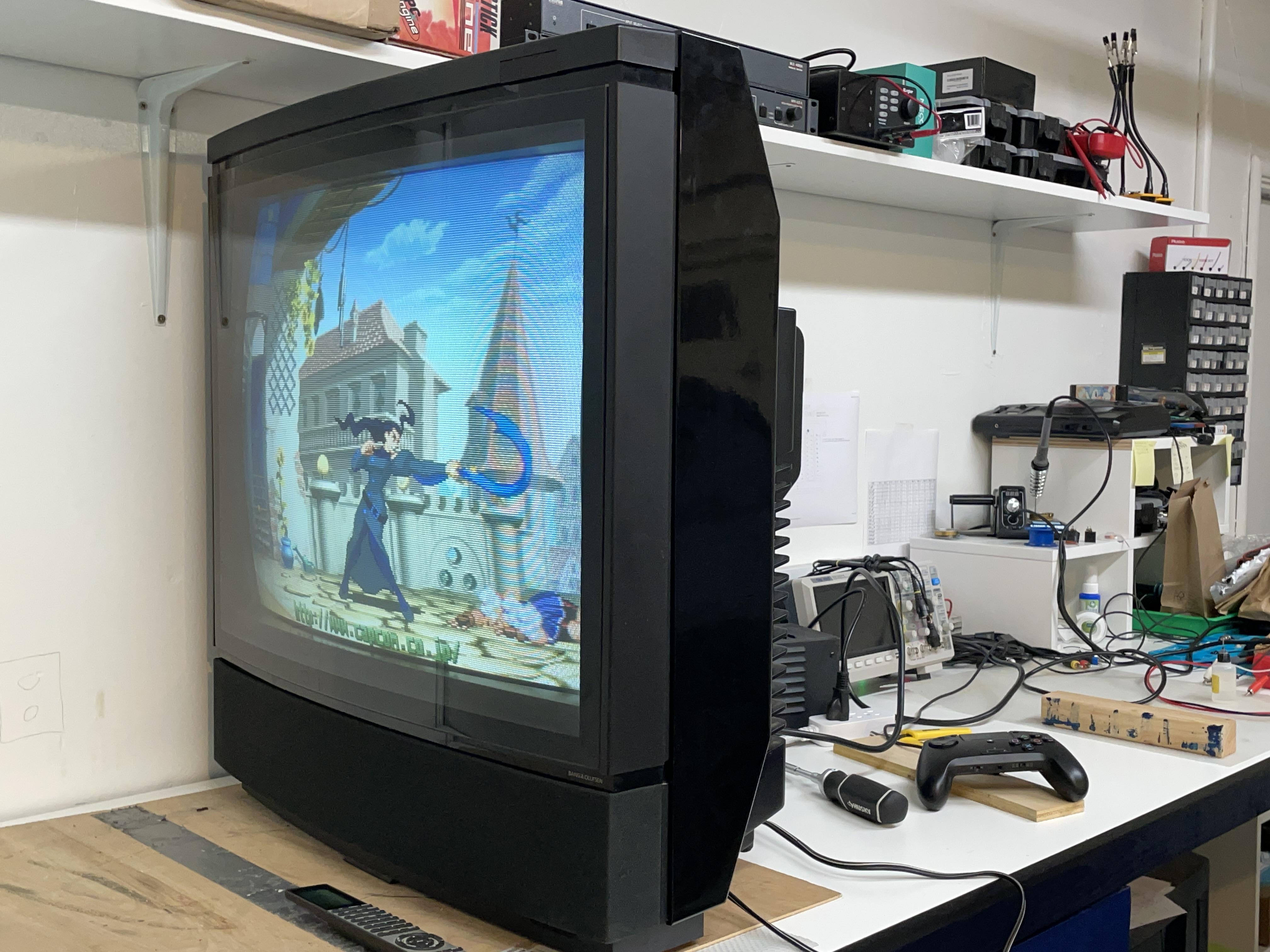
All of those diags were far beyond my capabilities, so I never would have gotten this running without help, and a monumental amount of help at that.
This B&O comes home next week, and then, I get started on the VX 5000 repairs….B&O first signs of life.
A little update! The guys working on my TV made a bit of progress on the deflection board, determined the flyback was likely ok, but it still had a short somewhere that was blowing fuses. Luckily, another B&O ended up at an e-waste facility nearby, and while it wasn’t in great shape, it did turn on, at least for a little bit! So, its boards were harvested, and between the two, they’ve gotten mine to finally turn on for the first time in maybe 20 years! Unfortunately, it looks like my tube is worn out, so we’re checking to see if the e-waste tube is in better shape, or if mine can be rejuvenated.
On a side note, when I dropped by black set off, in the garage was the red e-waste set, and a blue one my guy had just finished reparing, so it was a crazy site seeing all three sets together in one place. Will update again when I’ve got more info.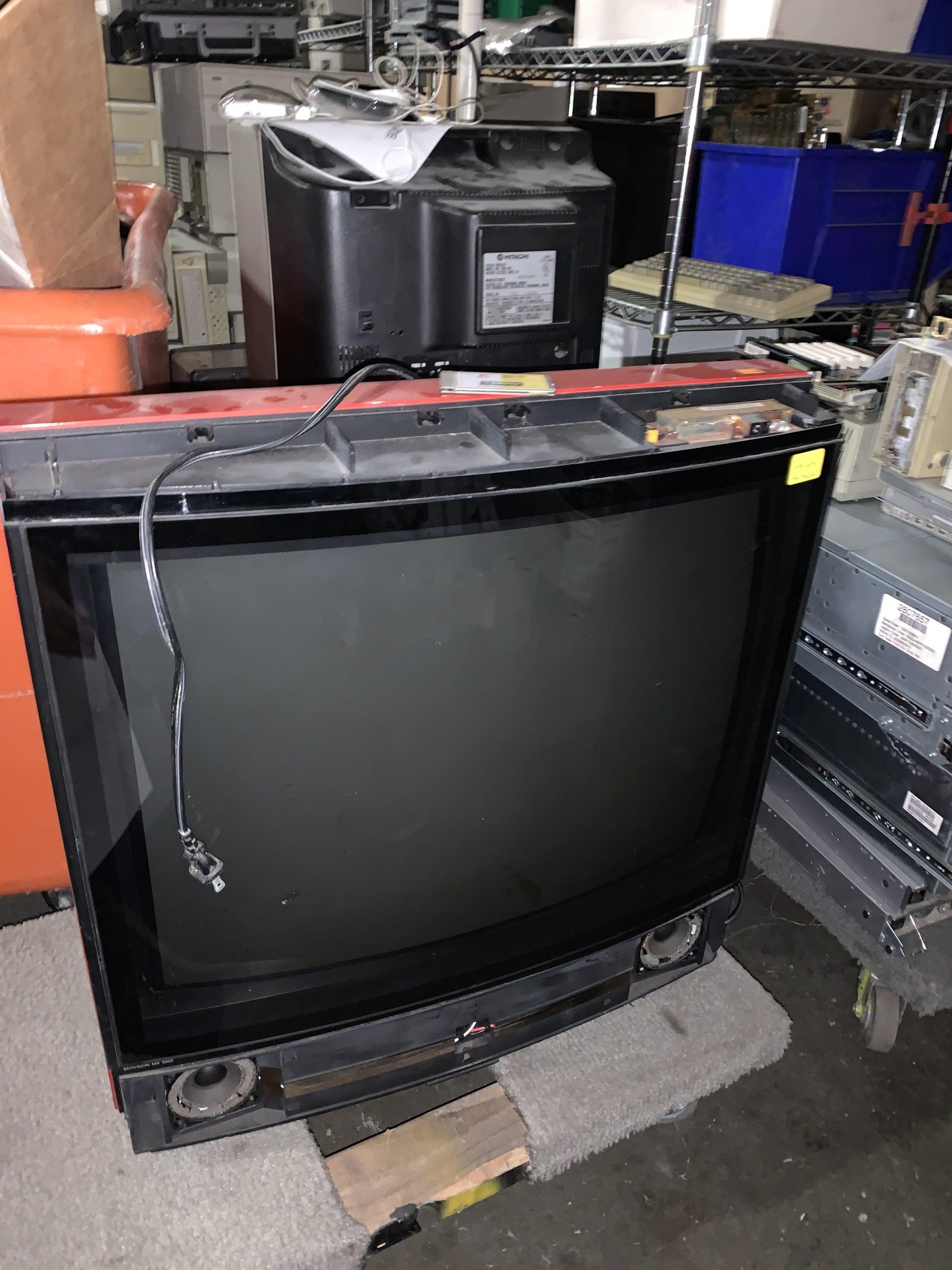
Well guys, I have an update today, and unfortunately, it looks like flyback failure. I was fortunate enough to have some friends in the Bay Area with another MX-5500 they were working on, and were willing to swap boards from mine for testing so I wouldn’t have to drive the whole TV down there.
They were able to trace back the problem to the protection in the switching power supply: IC1 is a TDA2582 and all pins are on spec except pin2 that checks the flyback pulse for a duration of ~12us coming directly from the HOT (through a few caps and a resistor, no coils)
They tested the flyback and noticed that the pulse was very very short (2-3us). They thought it was because there was no yoke coil connected, but this seems to indicate the very same symptom, and the yoke is connected this time.
So the guess is that the flyback is dead at this point.Now, I’m able to find some B&O flybacks available through Donberg, but these all appear to be for Euro sets, not American ones, which makes sense, but is unfortunate.
If anyone has any info on finding one of these guys, I’d sure appreciate it!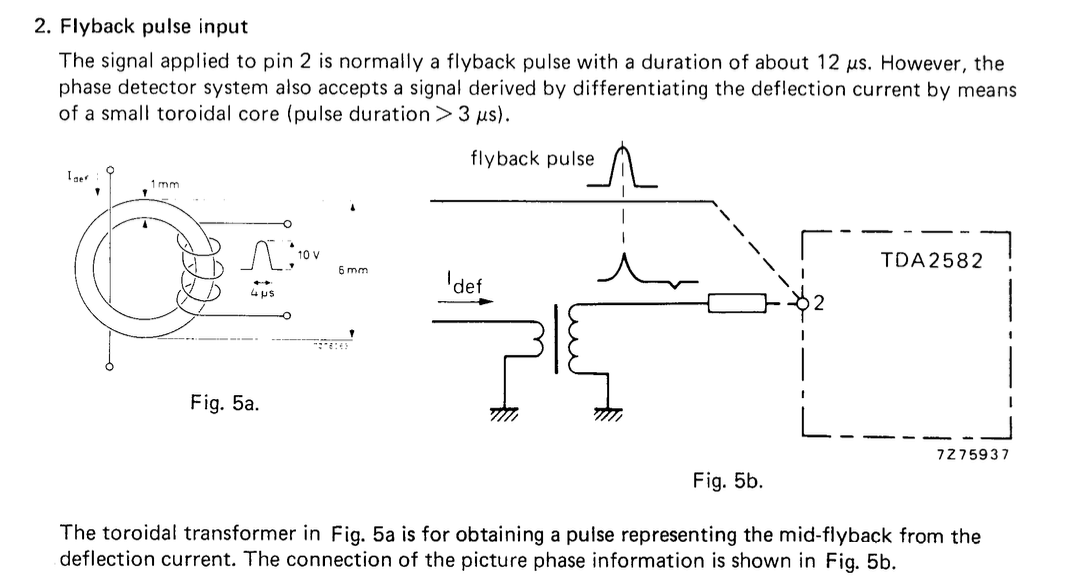
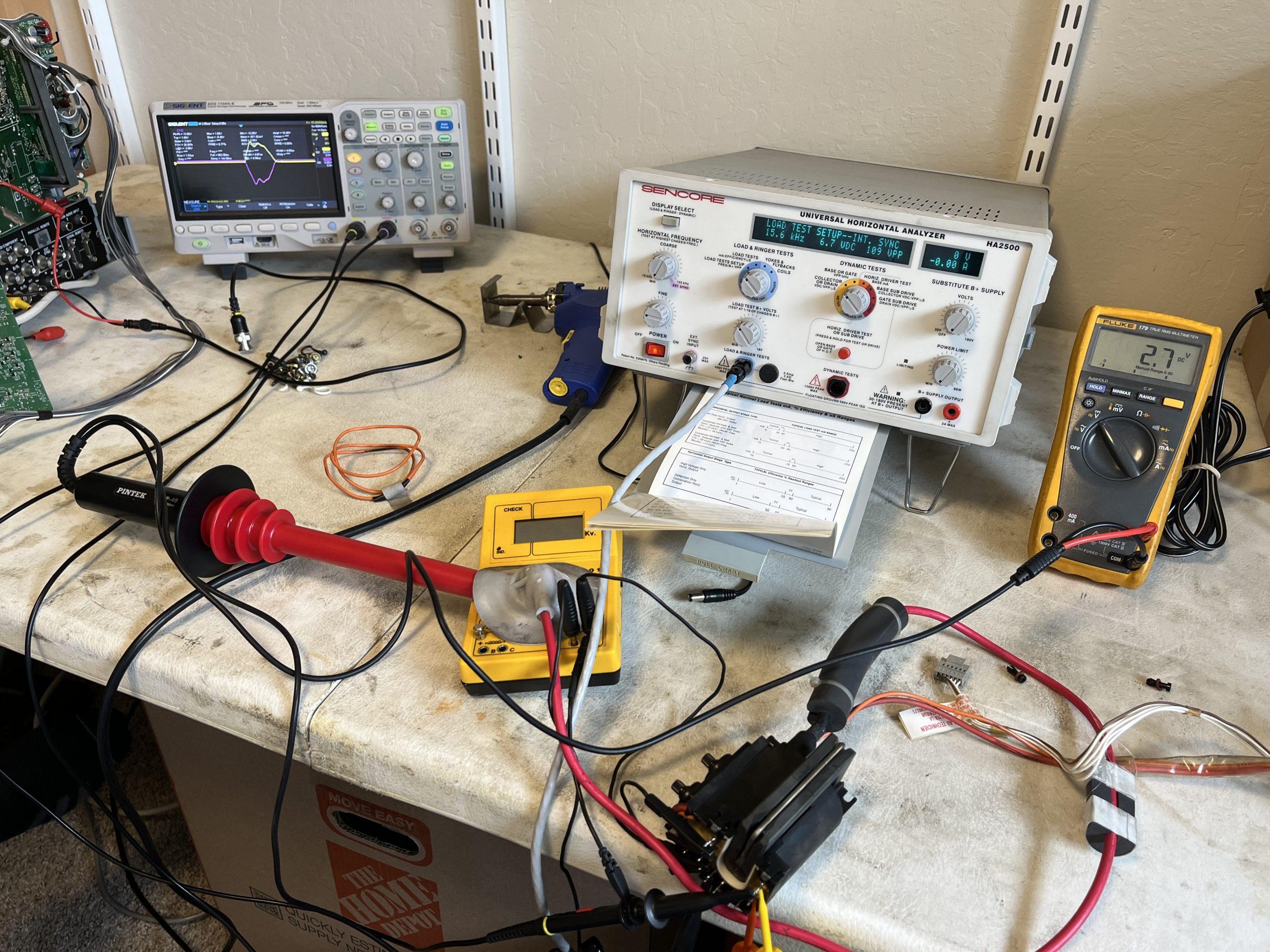
Good luck! Sorry, mine still isn’t working. While I’ve made progress on a pile of other TVs with weird issues, I haven’t been as lucky with this one. If I ever find out what’s definitively wrong with it, and if there are any fixes, I’ll be sure to put anything I find out in here.
Well, all the boards have been completely recapped, but the TV isn’t springing to life yet.
It goes into standby mode, and I can turn it on, which makes the red light go out, but nothing shows up on screen. The step button doesn’t do anything, we can only turn it on with the remote.
We’re poking around, and will hopefully have an update in the coming weeks.I’m sorry that happened! It’s always frustrating when something fails due to a mistake. I’ve certainly had it happen to me before, and the lessons have been expensive 😉
Cap replacement is definitely job #1, and I get to start it today! Mouser delivered over the weekend, and the tedious process is already underway.
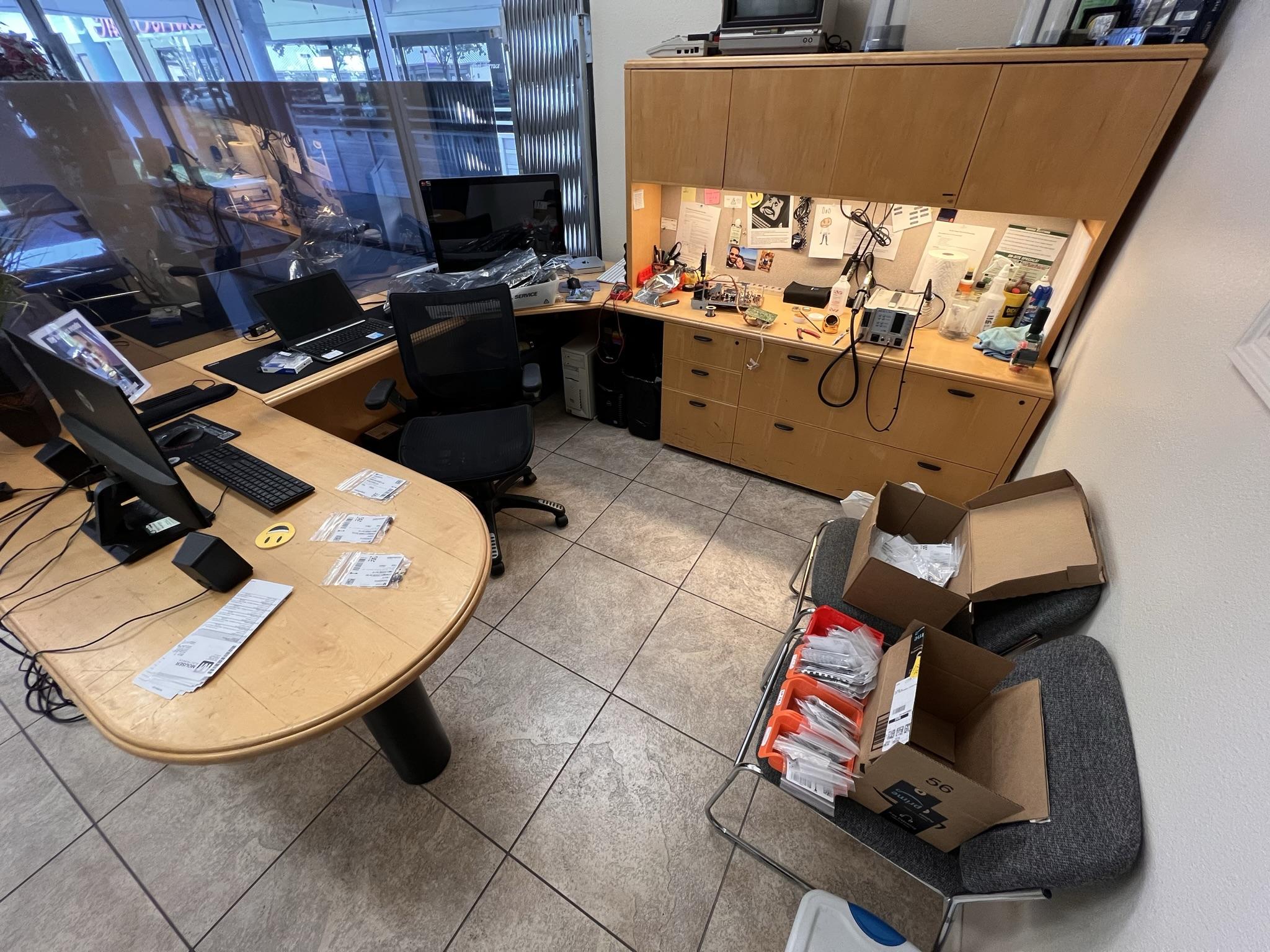
Thanks for the heads up regarding PCB 6. I can already see a lot of damage, and hopefully, I won’t make it worse in the process.
Finally finished the cap map for all the PCBs. Caps have been ordered, and I’ll be able to get started replacing all these little guys next week. Here are the maps for your enjoyment.
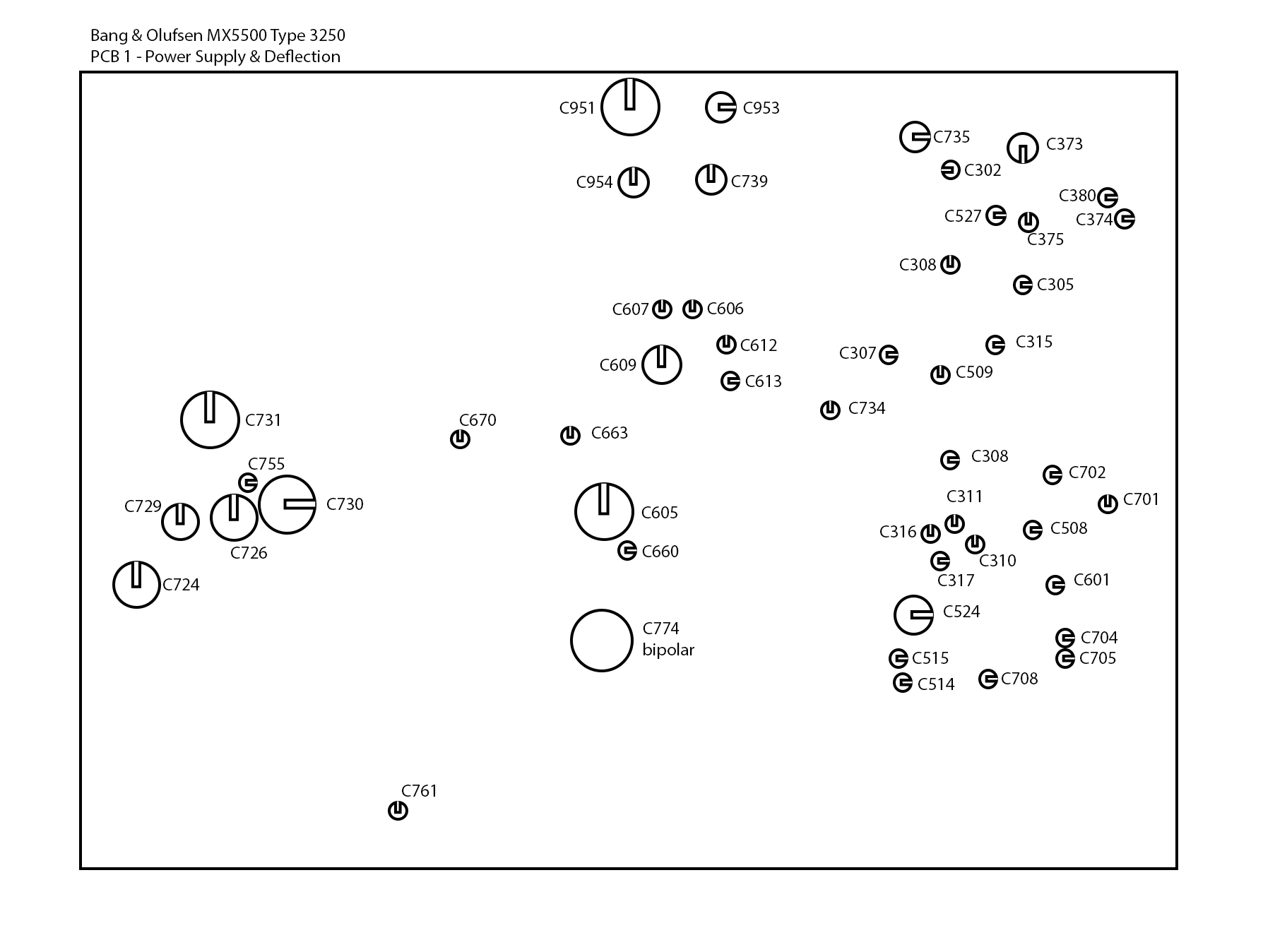
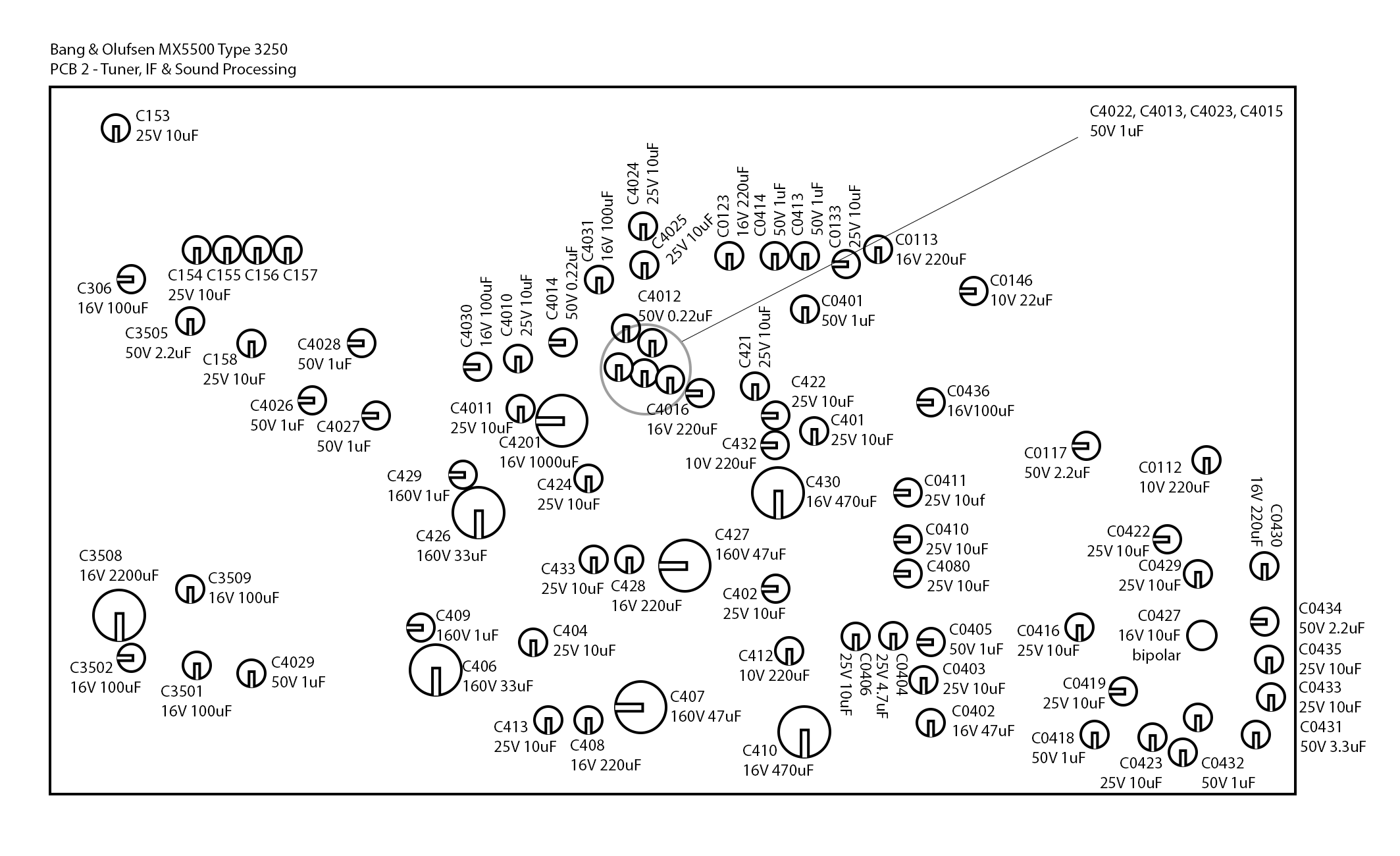
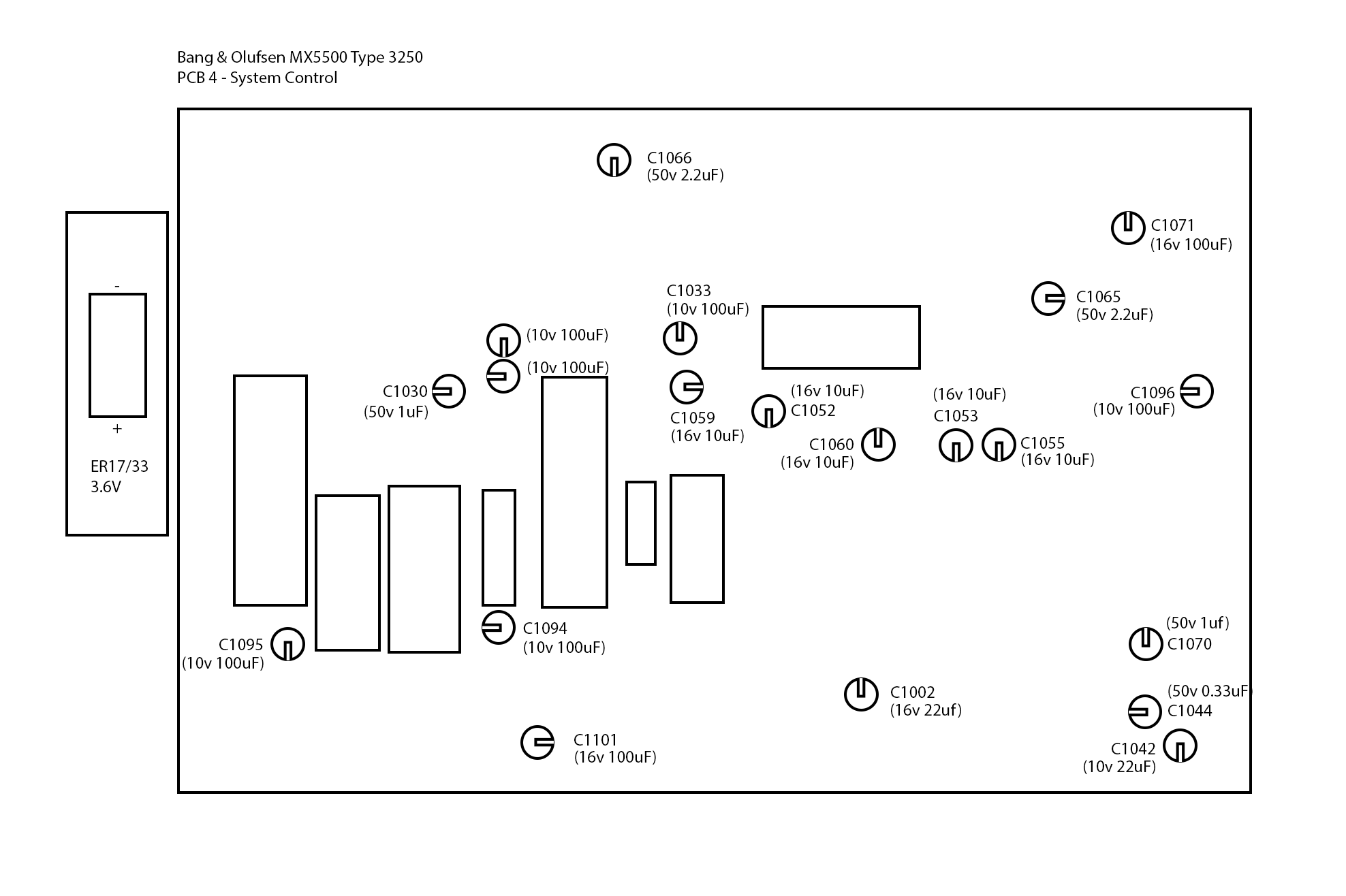
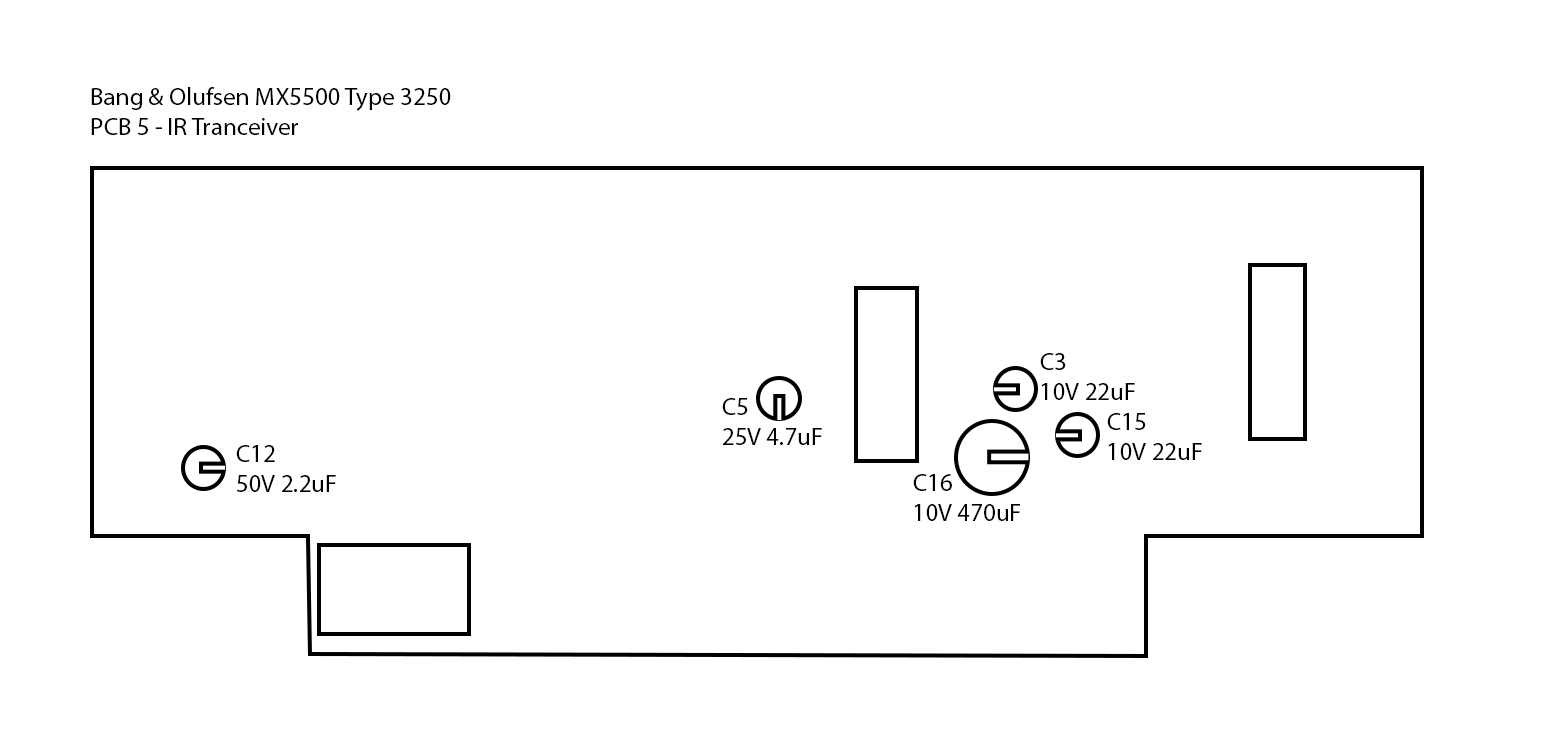
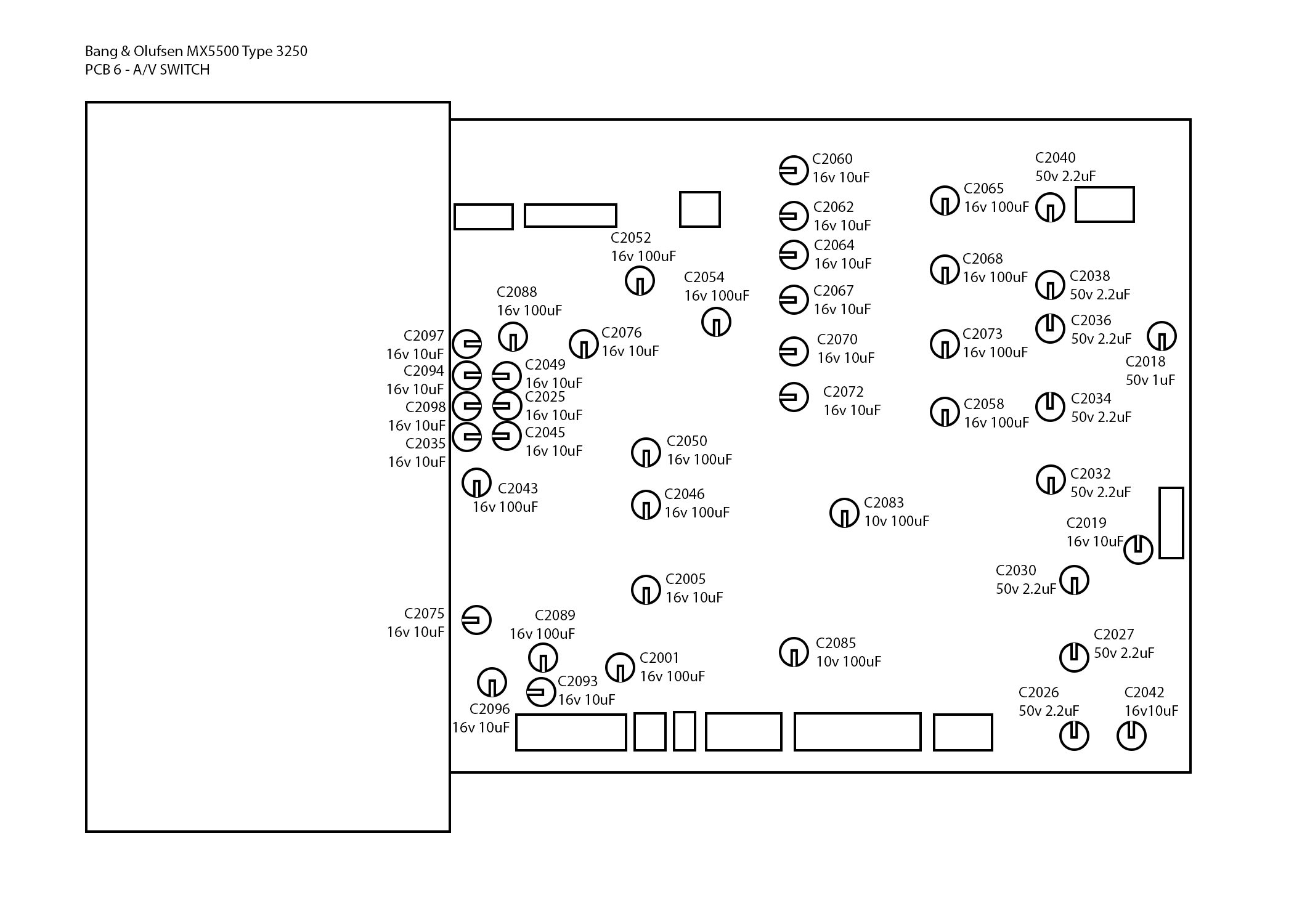
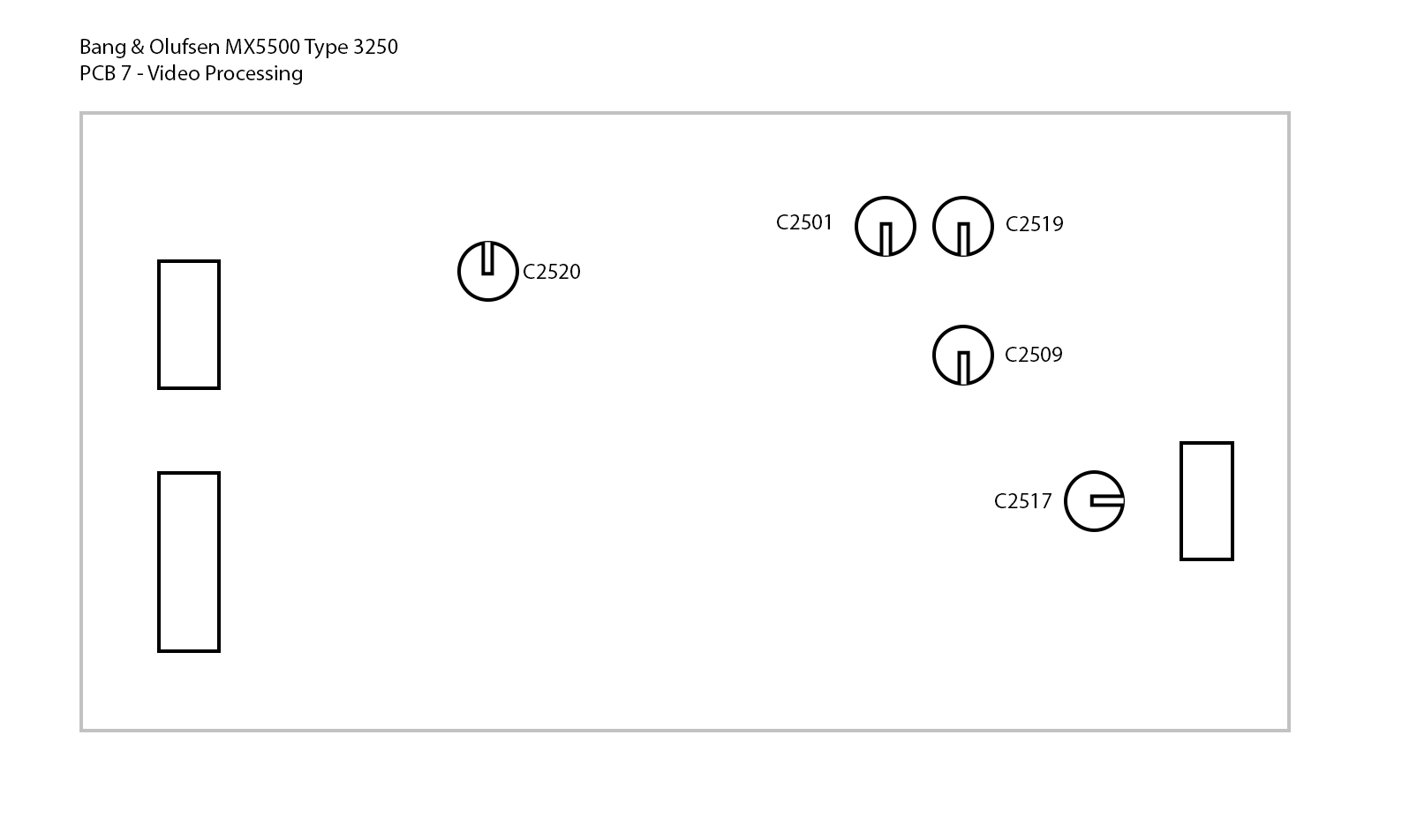
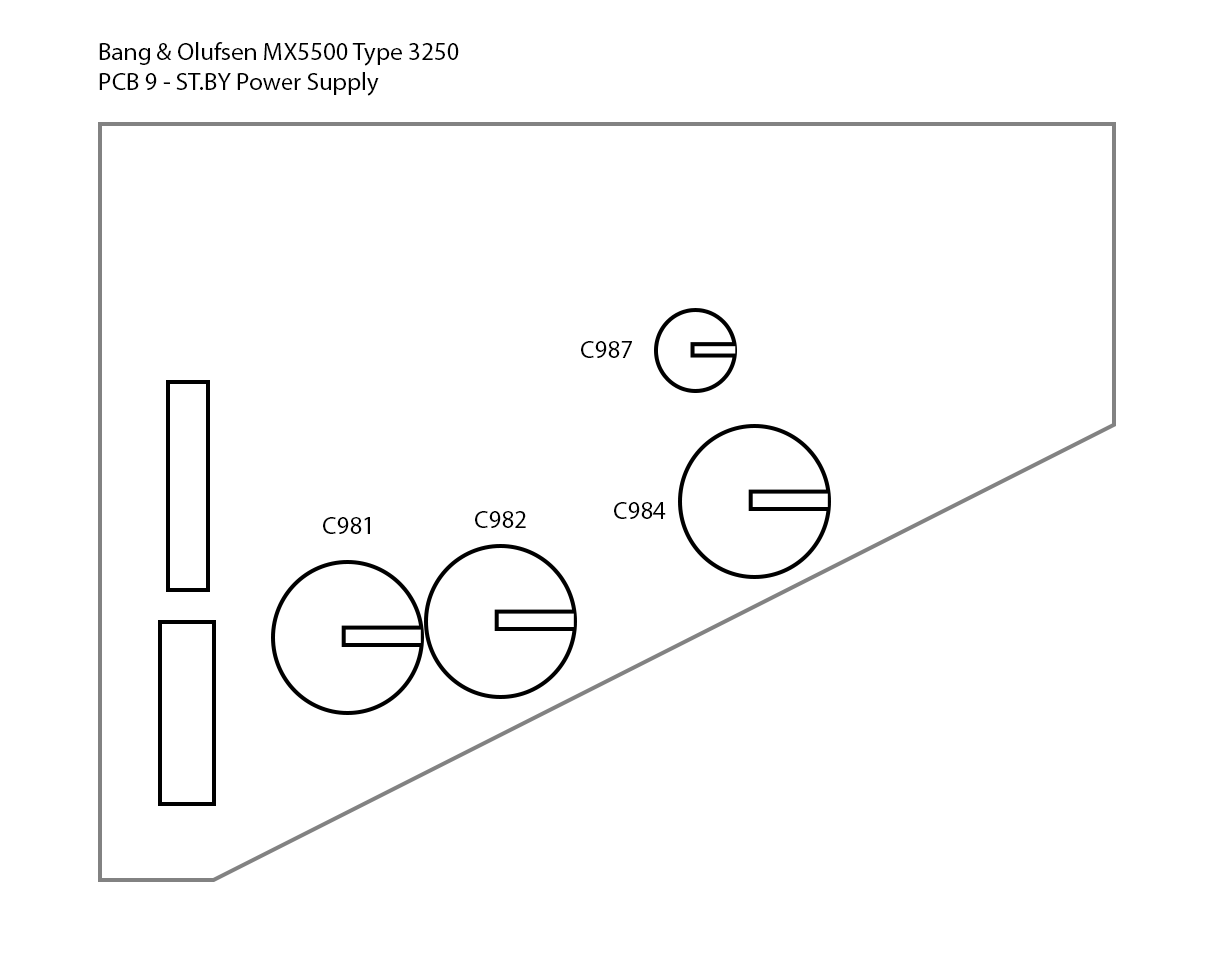
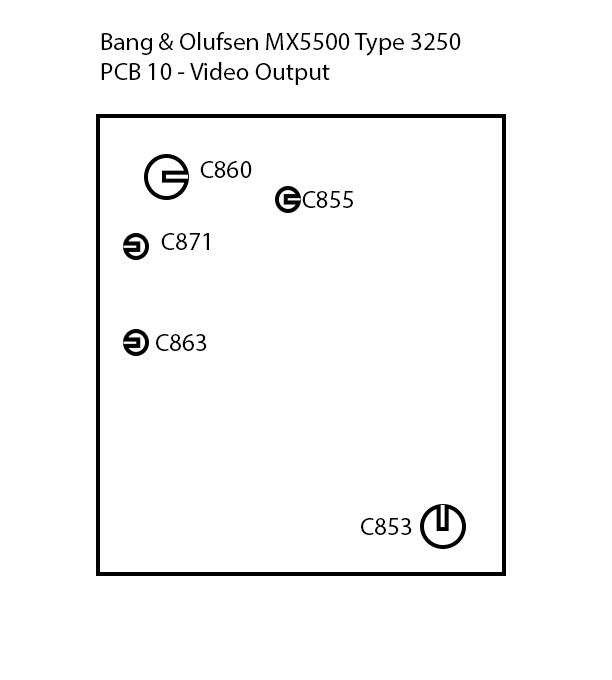
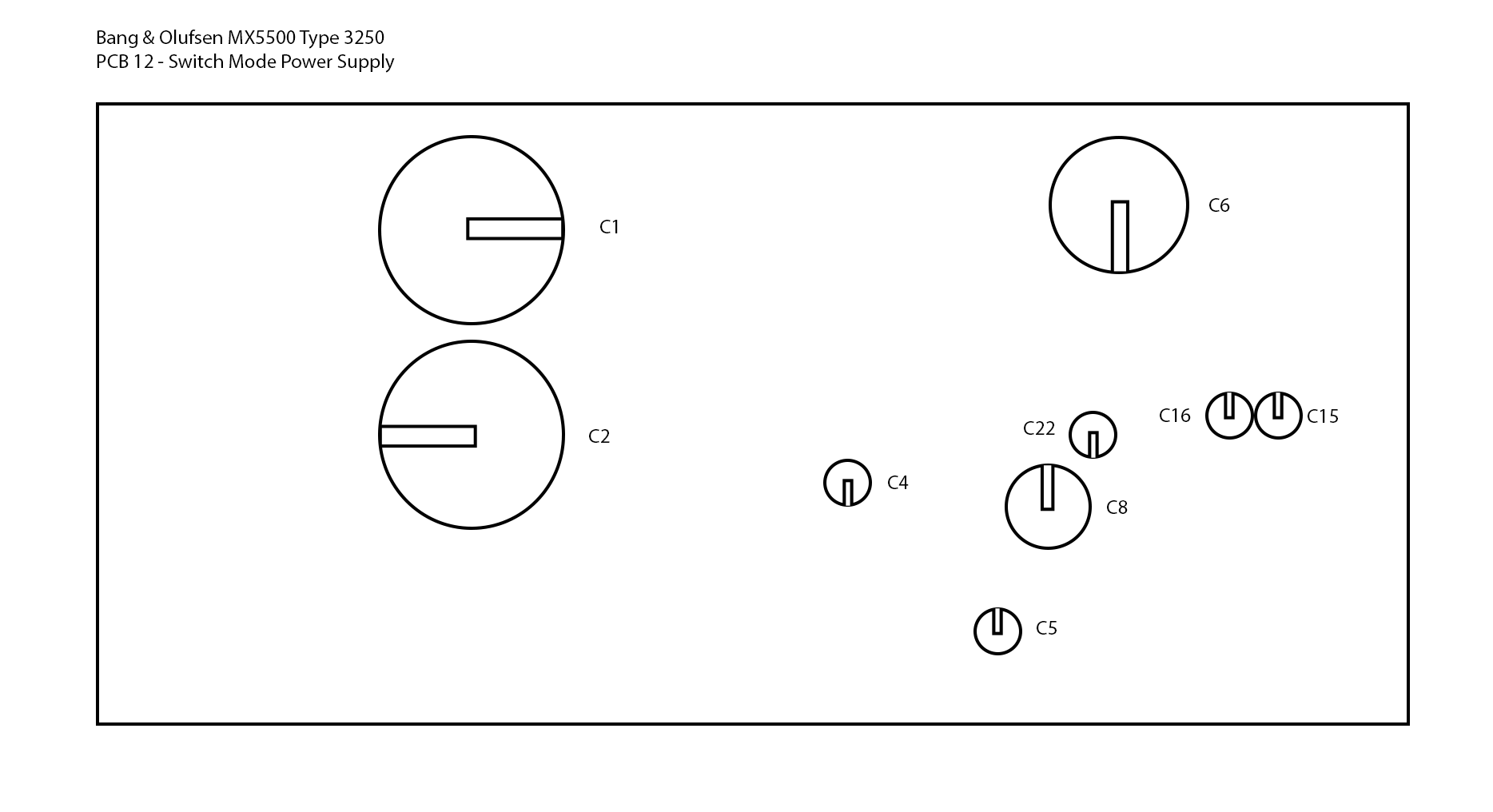
Still working on scanning the service manuals. Will get those uploaded soon.
Yesterday’s project was removing all the individual boards for full capacitor inspection. The service manual shows all the boards in this map, and to make it make sense, they have swung out the boards shown on the right as they are all connected together on a rail that unclips from the back.
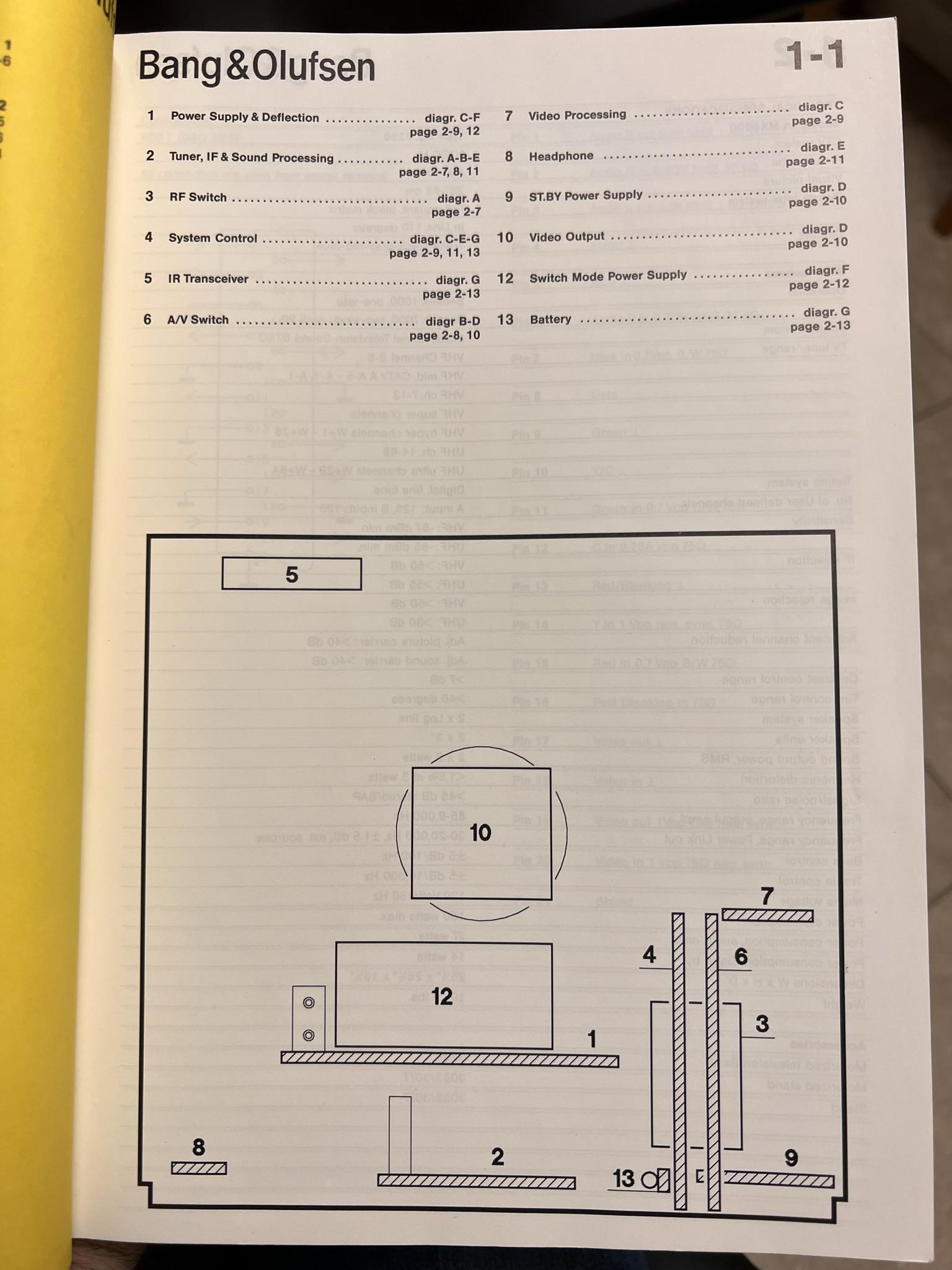
The only tricky part in removing the boards was that PCB 2 has an RF cable soldered to its connection, so you just need to heat it gently and pull it off with some needle nose pliers. The rest are just connected by an incredible hydra of wiring, but thankfully, each connector is labeled with the port it connects to, so as long as you go in order, reassembly shouldn’t be too difficult.
PCB 1 – Power Supply and Deflection
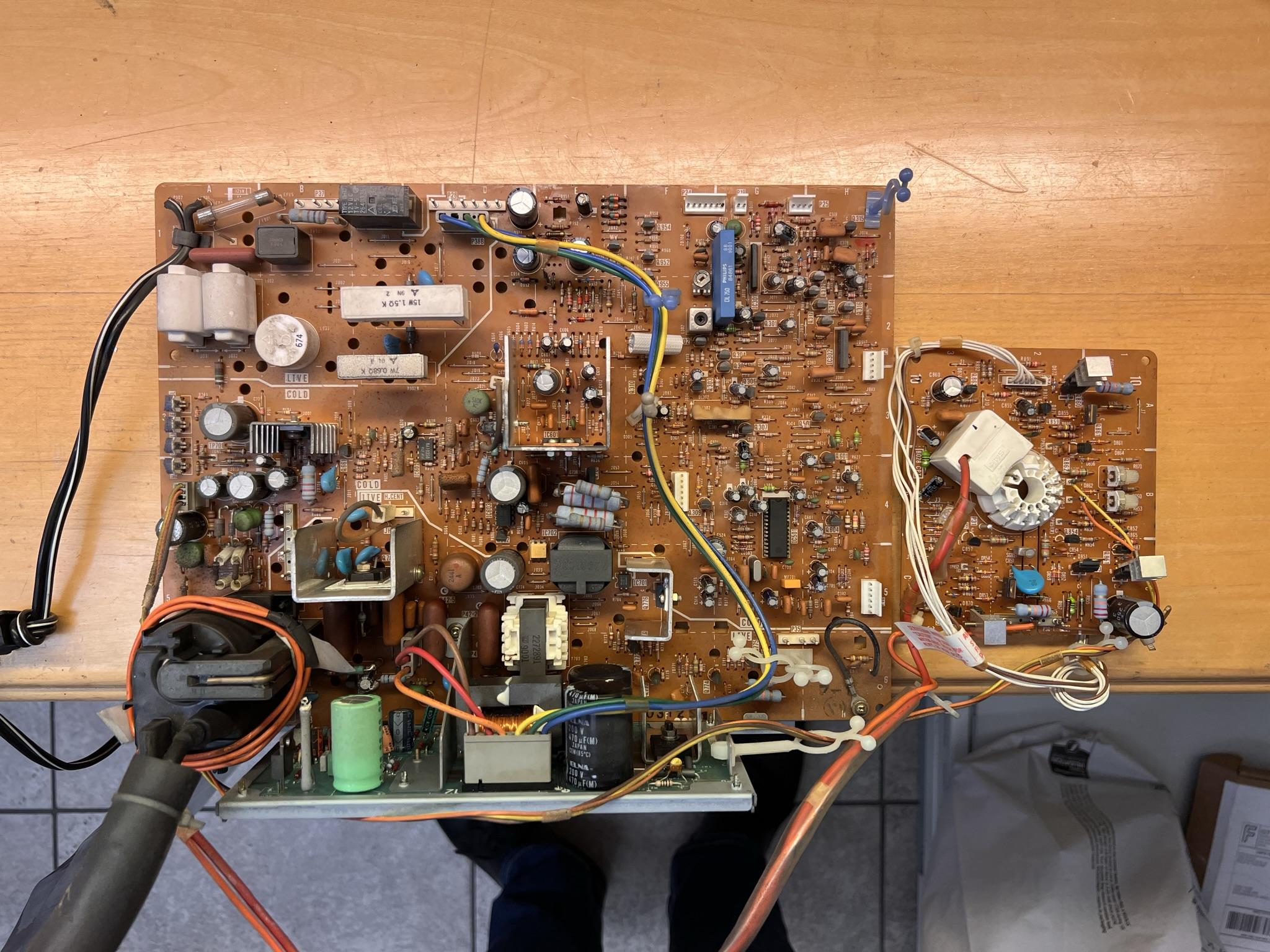
This pic actually shows PCB 1 – the main board, PCB 12 – Switch mode power supply, and PCB 10 – Video Output, as they are all interconnected. When I removed the Anode cap, I got no spark at all from a grounded screwdriver, so it’s likely that we aren’t getting power to the flyback at all. The main fuse is intact and shows continuity, and no obviously bad caps present themselves, so we may have a dead transistor or maybe even the flyback. The caps will all get replaced regardless, and then further testing can progress.
PCB 2 – Tuner, IF and Sound Processing
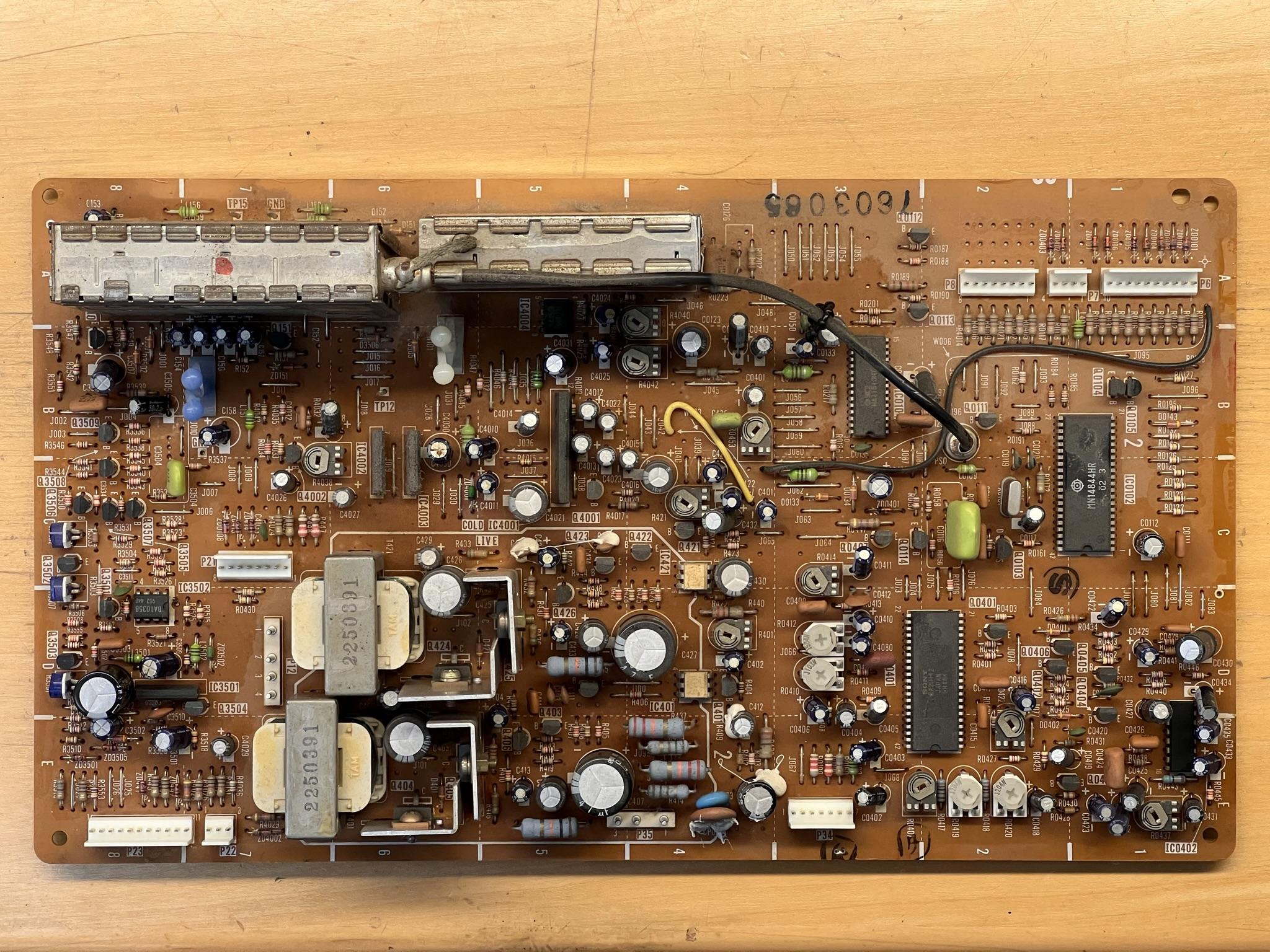
Here’s where I find the first obviously bad cap. C4030, in the middle above the two transformers has a rusty top.
PCB 4 – System Control
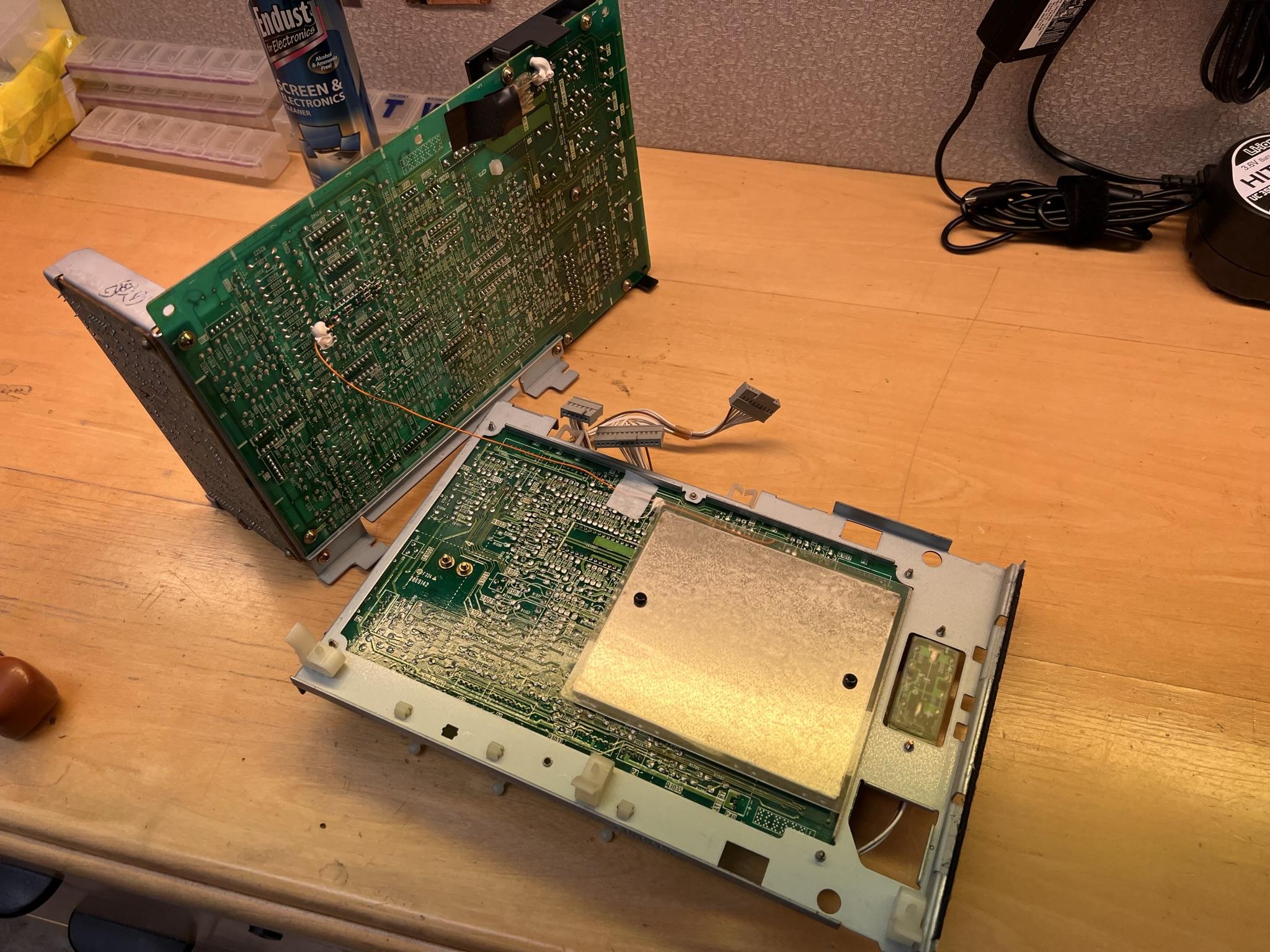
PCB 4, 6 and 7 are all screwed and clipped together. There is an orange wire that goes between them that has to be desoldered.
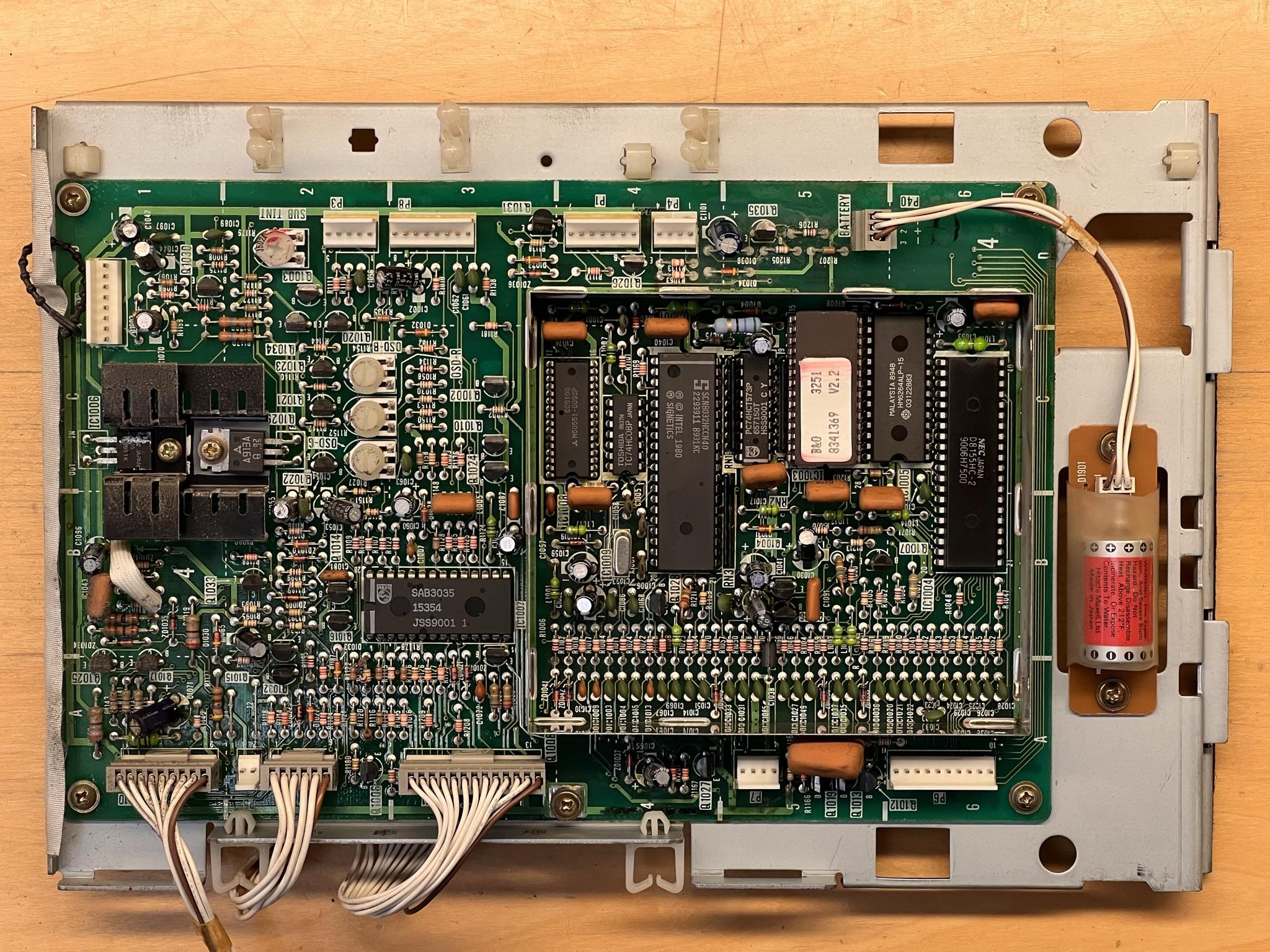
System control contains the CPU, BIOS and the rest of the chipset, all connected to a 3.6V battery that miraculously is not dead and leaky, but also is still running at 3.3V! Quite a few bad caps in here, especially in the little processor village. On the opposite side of this board is a steel cover that has been soldered, so that will need to be desoldered to reach bottom of the board for the cap replacement.
PCB 6 – AV Switch
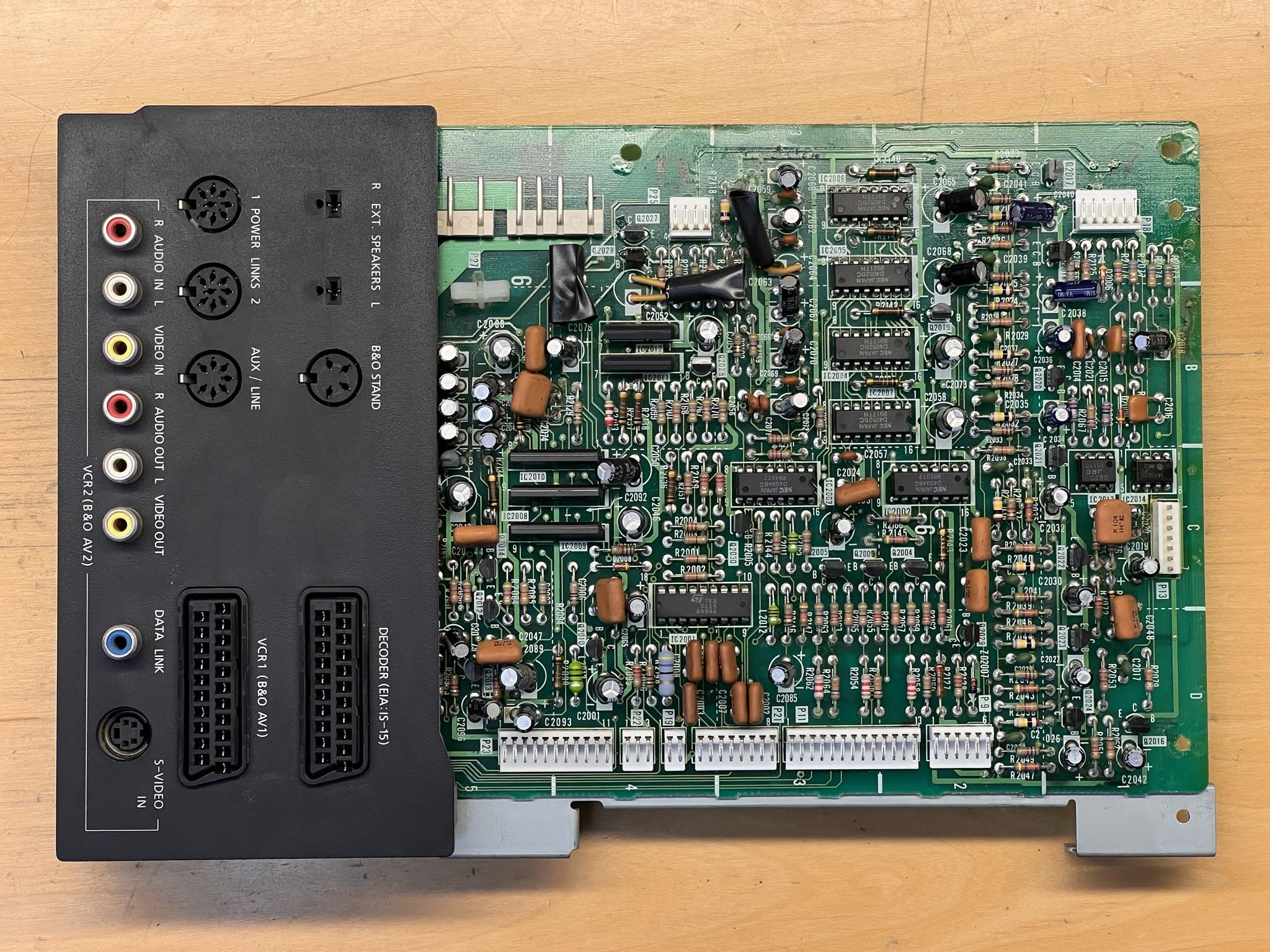
The only thing to address on this one will be to make sure the discoloration at the top is not trace corrosion. If it is, some bodge wire will need to be run after the caps are replaced.
PCB 7 – Video Processing

This little guy attaches to the top of PCB 4 & 6, and only has a few caps.
PCB 9 – Standby Power Supply
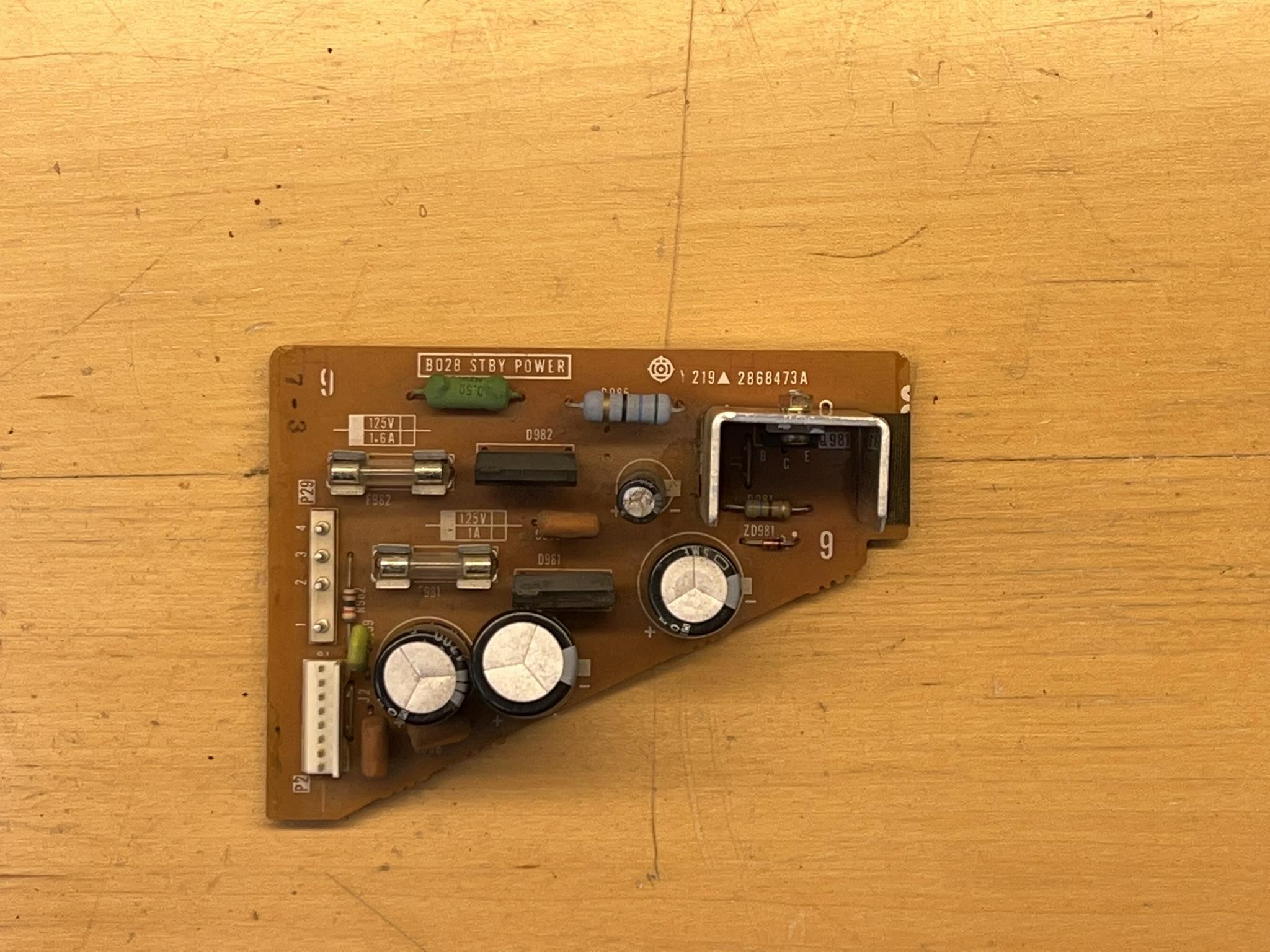
Because the TV turns on into standby mode, it’s assumed that this guy is fine. The fuses check out, and the transistor passes diags as well.
PCB 12 – Switch Mode Power Supply
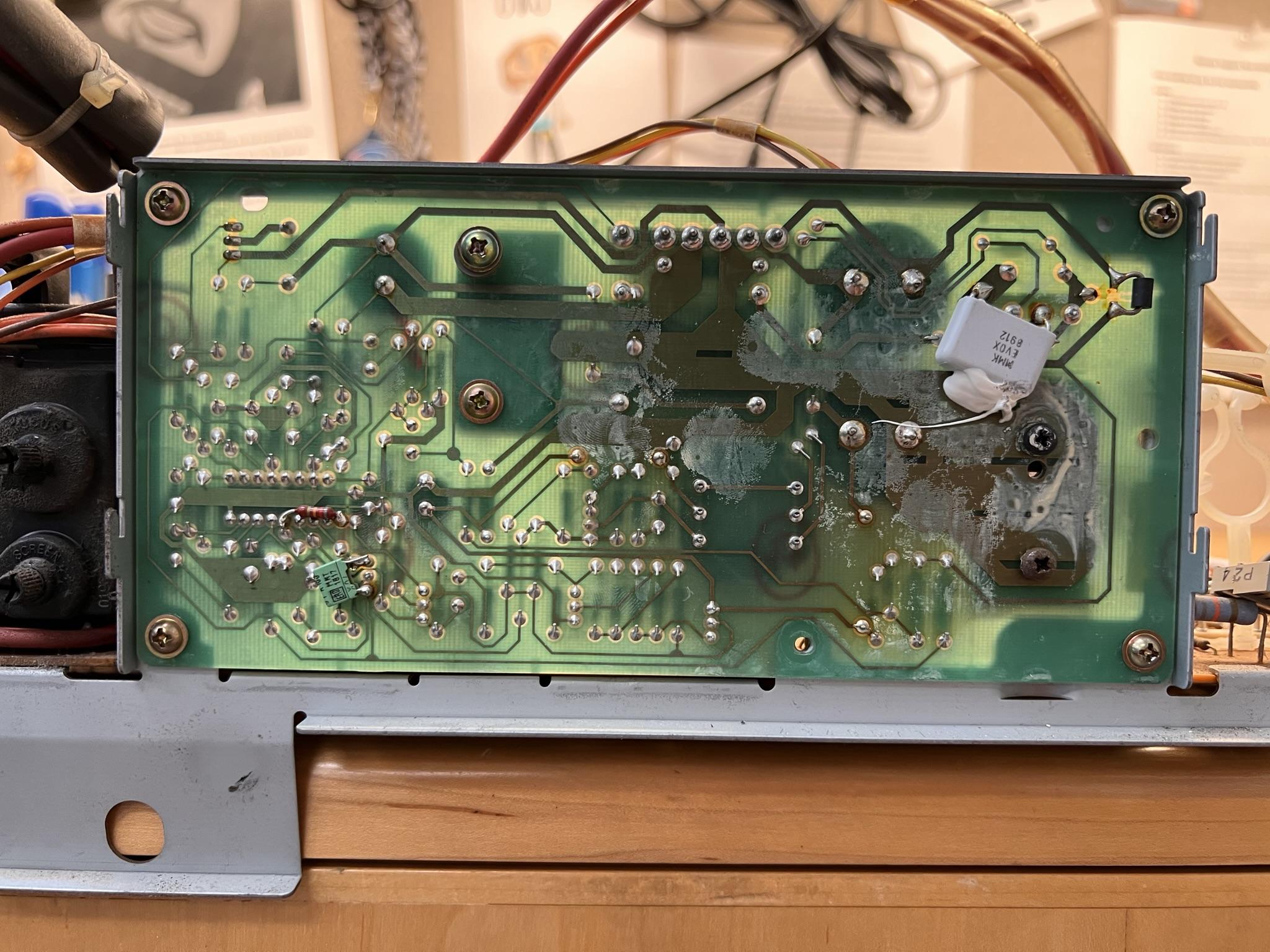
This is the back of the PCB, attached to PCB 1.
A few PCB pics were omitted, like the power and step button board, since there’s really nothing to it, but it was tested for continuity and confirmed working. I don’t have a pic of PCB 5 – IR Receiver, because I forgot it at home. Visually, it looks fine, and just has 3 caps.
The next step is to make a capacitor map based on the pics here, put an order in to mouser, and see where we’re at after that.
Coming soon will be scans of the American Service Manual and the regular manual, unless you guys have that stuff already.Also, if anyone has any advice or sees something I don’t see, by all means, please let me know. I’ve repaired a few arcade game PCBs and some old consoles, but there’s a lot here that I’m learning for the first time, so any tips would be appreciated.
Oh wow, that is totally different. Yes, it’s the US model.
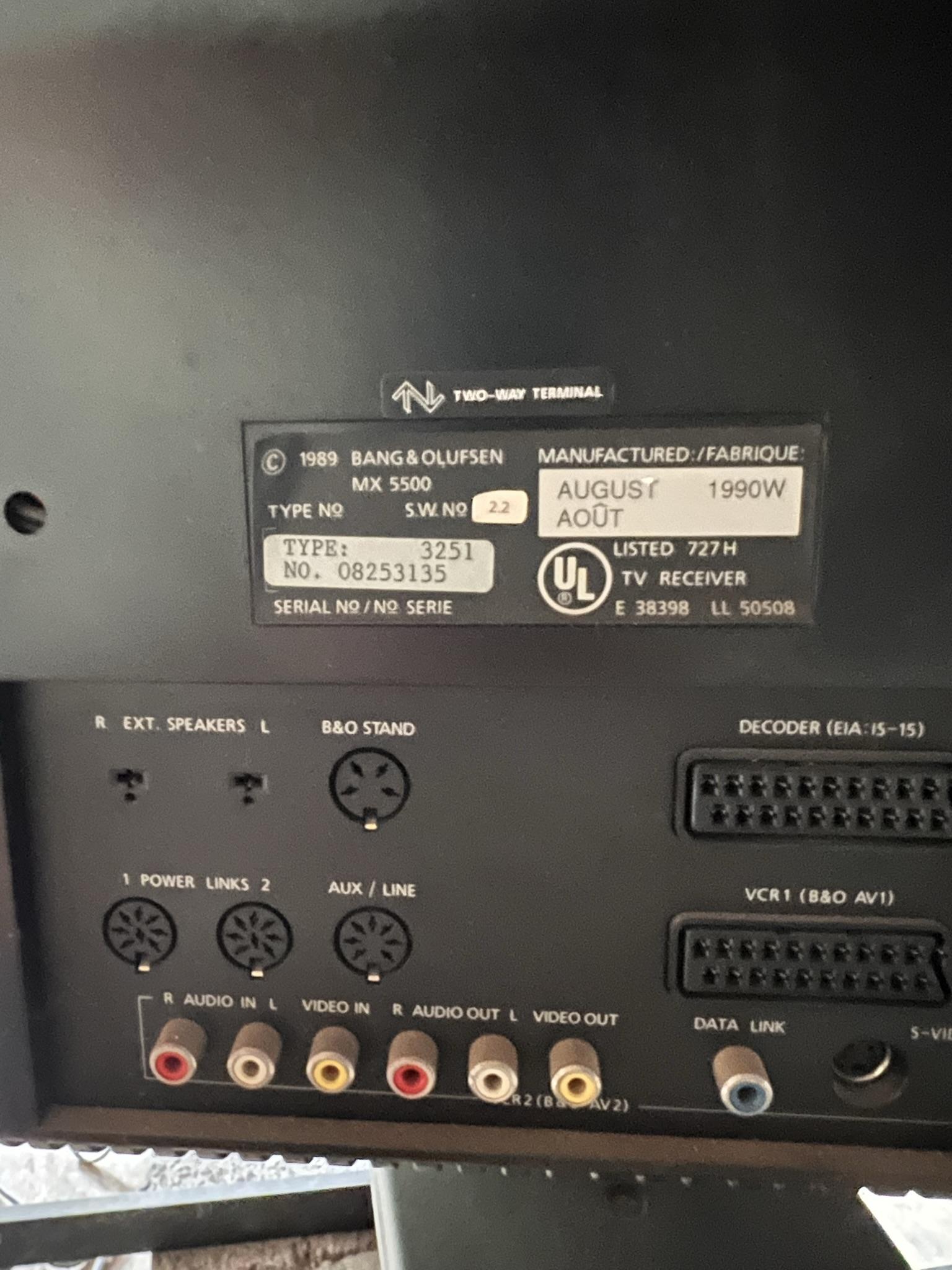
- AuthorPosts
